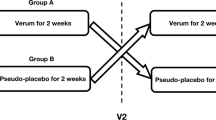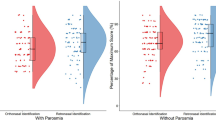Abstract
In Kallmann syndrome (KS), congenital hypogonadism is associated with olfactory impairment. To evaluate flavor perception-related disability in KS patients, 30 patients with KS, 12 with normosmic hypogonadism (nIHH), 24 with acquired anosmia (AA), and 58 healthy controls entered the study. All participants completed questionnaires concerning dietary habits, olfaction-related quality of life (QoL), and self-determined olfactory, flavor, and taste abilities prior to undergoing standardized olfactometry and gustometry. Each subject underwent flavor testing, using orally administered aqueous aromatic solutions, identifying 21 different compounds by choosing each out of 5 alternative items. Flavor score (FS) was calculated as the sum of correct answers (range 0–21). Flavor perception by self-assessment was similar between KS, nIHH, and controls, and was mostly reduced only in AA. FS was similar between KS (5.4 ± 1.4) and AA (6.4 ± 1.9), and lower than in nIHH (16.2 ± 2.4, p < 0.001) and controls (16.8 ± 1.7, p < 0.0001). FS showed strong reproducibility, and correlated with olfactory scores in the overall population. KS and AA patients identified aromatics eliciting trigeminal stimulation better than pure odorants. Olfaction-related QoL was more impaired in AA than in KS. We report significant flavor impairment in KS. This contrasts with routine clinic evidence; KS patients, in contrast with AA, do not complain of flavor perception impairment, perhaps owing to the congenital nature of the dysfunction. Flavor perception impairment should be considered a specific KS disability, because of important detrimental effects on physical and mental health and on QoL. KS patients should also be advised of this impairment in order to prevent accidental and life-threatening events.

Similar content being viewed by others
References
J. Young, Approach to the male patient with congenital hypogonadotropic hypogonadism. J. Clin. Endocrinol. Metab. (2012). doi:10.1210/jc.2011-1664
H.M. Lewkowitz-Shpuntoff, V.A. Hughes, L. Plummer, M.G. Au, R.L. Doty, S.B. Seminara, Y.M. Chan, N. Pitteloud, W.F. Crowley, R. Balasubramanian, Olfactory phenotypic spectrum in idiopathic hypogonadotropic hypogonadism: pathophysiological and genetic implications. J. Clin. Endocrinol. Metab. (2012). doi:10.1210/jc.2011-2041
K.S. Hasan, S.S. Reddy, N. Barsony, Taste perception in kallmann syndrome, a model of congenital anosmia. Endocr. Pract. (2007). doi:10.4158/EP.13.7.716
S.S. Schiffman, Taste and smell losses in normal aging and disease. JAMA 278, 1357–1362 (1997)
M.A. Martinez-Gonzalez, A. Garcia-Arellano, E. Toledo, J. Salas-Salvado, P. Buil-Cosiales, D. Corella, M.I. Covas, H. Schroder, F. Aros, E. Gomez-Gracia, M. Fiol, V. Ruiz-Gutierrez, J. Lapetra, R.M. Lamuela-Raventos, L. Serra-Majem, X. Pinto, M.A. Munoz, J. Warnberg, E. Ros, R. Estruch, A 14-item Mediterranean diet assessment tool and obesity indexes among high-risk subjects: the PREDIMED trial. PLoS One (2012). doi:10.1371/journal.pone.0043134
J. Frasnelli, T. Hummel, Olfactory dysfunction and daily life. Eur. Arch. Otorhinolaryngol. (2005). doi:10.1007/s00405-004-0796-y
T. Hummel, G. Kobal, H. Gudziol, A. Mackay-Sim, Normative data for the “Sniffin’ Sticks” including tests of odor identification, odor discrimination, and olfactory thresholds: an upgrade based on a group of more than 3,000 subjects. Eur. Arch. Otorhinolaryngol. (2007). doi:10.1007/s00405-006-0173-0
J. Pingel, J. Ostwald, H.W. Pau, T. Hummel, T. Just, Normative data for a solution-based taste test. Eur. Arch. Otorhinolaryngol. (2010). doi:10.1007/s00405-010-1276-1
L. Maione, I.C. Nettore, A. Colao, R. Pivonello, E. Cantone, N. Maione, C. Eloit, Y. Young, Altération de la perception des goûts chez des patients avec syndrome de Kallmann : une atteinte neurosensorielle méconnue. Ann. Endocrinol. (2014). doi:10.1016/j.ando.2014.07.067
J.F. Bosma, R.I. Henkin, R.L. Christiansen, J.R. Herdt, Hypoplasia of the nose and eyes, hyposmia, hypogeusia, and hypogonadotrophic hypogonadism in two males. J. Craniofac. Genet. Dev. Biol. 1, 153–184 (1981)
J.M. Graham Jr, J. Lee, Bosma arhinia microphthalmia syndrome. Am. J. Med. Genet. A 140, 189–193 (2006)
S.C. Kinnamon, R.F. Margolskee, Mechanisms of taste transduction. Curr. Opin. Neurobiol. 6, 506–513 (1996)
D.M. Small, J. Prescott, Odor/taste integration and the perception of flavor. Exp. Brain Res. (2005). doi:10.1007/s00221-005-2376-9
T. Hummel, H. Pietsch, G. Kobal, Kallmann’s syndrome and chemosensory evoked potentials. Eur. Arch. Otorhinolaryngol. 248, 311–312 (1991)
J. Frasnelli, B. Schuster, T. Hummel, Interactions between olfaction and the trigeminal system: what can be learned from olfactory loss. Cereb. Cortex (2007). doi:10.1093/cercor/bhl135
T. Hummel, S. Barz, J. Lotsch, S. Roscher, B. Kettenmann, G. Kobal, Loss of olfactory function leads to a decrease of trigeminal sensitivity. Chem. Senses 21, 75–79 (1996)
R.L. Doty, E.L. Cameron, Sex differences and reproductive hormone influences on human odor perception. Physiol. Behav. (2009). doi:10.1016/j.physbeh.2009.02.032
S. Nordin, A.U. Monsch, C. Murphy, Unawareness of smell loss in normal aging and Alzheimer’s disease: discrepancy between self-reported and diagnosed smell sensitivity. J. Gerontol. B Psychol. Sci. Soc. Sci. 50, P187–P192 (1995)
R.I. Henkin, L.M. Levy, Functional MRI of congenital hyposmia: brain activation to odors and imagination of odors and tastes. J. Comput. Assist. Tomogr. 26, 39–61 (2002)
B.S. Naik, N. Shetty, E.V. Maben, Drug-induced taste disorders. Eur. J. Intern. Med. (2010). doi:10.1016/j.ejim.2010.01.017
S.S. Schiffman, B.G. Graham, Taste and smell perception affect appetite and immunity in the elderly. Eur. J. Clin. Nutr. 54(Suppl 3), S54–S63 (2000)
S.S. Schiffman, J. Zervakis, Taste and smell perception in the elderly: effect of medications and disease. Adv. Food Nutr. Res. 44, 247–346 (2002)
S.S. Schiffman, Effects of aging on the human taste system. Ann. N. Y. Acad. Sci. (2009). doi:10.1111/j.1749-6632.2009.03924.x
Acknowledgments
We thank the Campus Salute Onlus for collaborating with Federico II University, and for allowing the enrolment of a sample population drawn from educational and preventive medical programs particularly addressed to the general population. We are grateful to Dr Corinne Eloit for her competence and expertise in the domain of sensorineural abilities, and for her inspiring insights. We are indebted to Donato Creti, Francesca Trapani, and the entire team at Enrico GIOTTI spa for their commitment and for providing facilities to prepare and distribute the aromatic bases used in this study.
Author information
Authors and Affiliations
Corresponding author
Ethics declarations
Conflict of interest
All the Authors of this study declare they have no conflict of interest.
Additional information
Luigi Maione and Elena Cantone have contributed equally to this work.
Electronic supplementary material
Below is the link to the electronic supplementary material.
Rights and permissions
About this article
Cite this article
Maione, L., Cantone, E., Nettore, I.C. et al. Flavor perception test: evaluation in patients with Kallmann syndrome. Endocrine 52, 236–243 (2016). https://doi.org/10.1007/s12020-015-0690-y
Received:
Accepted:
Published:
Issue Date:
DOI: https://doi.org/10.1007/s12020-015-0690-y




